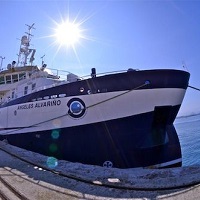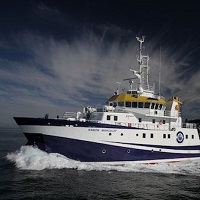Keyword
Molecular biology parameters
17 record(s)
Type of resources
Categories
Topics
INSPIRE themes
Keywords
Contact for the resource
Provided by
Years
Formats
Status
-

The general objective of SponGES 0617 expedition on board R/V Angeles Alvariño (IEO) was the study of sponge grounds in the Aviles Canyon System and Le Danois Bank (Study cases of SponGES project nº 4 and 5) where we had knowledge of their existence in the previous projects of IEO in the area (ECOMARG, INDEMARES, ESMAREC), in order to complete the objectives of SponGES project. Specific objectives: 1. Sampling of the structuring sponge species for both anatomical and morphological description and their identification through molecular tools. 2. Collection of samples that will be part of the reference collections, for the sponge grounds species and of the associated fauna. 3. Study of the associated fauna in areas of the target species and in nearby control areas. 4. Sampling of the microbial fauna associated with the target sponge species. 5. Investigate the microbial fauna in sea water collected by rosette and control sediments (Box Corer). 6. Transects with the Politolana ROTV for describing the habitats of structuring species using photogrammetric techniques based on qualitative and quantitative data (presence / density / abundance), as well as environmental data. 7. Sampling for reproductive ecology and genetic structure of target species.
-

The fertilization of phytoplankton by the Iberian upwelling is responsible for the production of ∼250,000 t year-1 of blue mussels in the Galician Rías. This amount represents 95% of the Spanish and 50% of the European production, respectively. This production is jeopardized every year by species from the genera Dinophysis and Pseudo-nitzschia, responsible for lengthy shellfish harvesting closures due to accumulation of diarrhetic (DSP) and amnesic (ASP) shellfish poisoning toxins, respectively, above regulatory levels. Previous studies in this region and others in Europe indicate that these species frequently aggregate forming “thin layers”. Less than five meters thick and up to several km in horizontal extension, these layers have important implications for the management of molluscan shellfish safety. Despite this, the frequency of occurrence of thin phytoplankton layers in the Galician Rías, and the role of mixing conditions in their formation and persistence remains unknown. This project combines field observations in the Galician Rías, time series analysis, and empirical and numerical modeling with the aim of 1) investigating the role of mixing on resource availability and phytoplankton bloom initiation, maintenance and dissipation, 2) describing the frequency and spatial distribution of thin layers of phytoplankton (TLP), and 3) investigating the mechanisms responsible for the formation of TLP.
-

To i nstall 6 moorings in the Avilés Canyon region. To conduct biological and geological sampling in the area, including both plankton and benthos.
-

Study the role of B vitamins on the community structure, activity and succesion of the microbial plankton in a coastal upwelling system.
-

Study the role of B vitamins on the community structure, activity and succesion of the microbial plankton in a coastal upwelling system.
-

To recovery 6 moorings in the Avilés Canyon region. To conduct biological and geological sampling in the area, including both plankton and benthos.
-

Study the role of B vitamins on the community structure, activity and succesion of the microbial plankton in a coastal upwelling system.
-

The scientific objectives of the cruise include the characterization of thermohaline fields, hydrodynamics, biogeochemistry and complementary biological measuremens in Atlantic Galician waters in a transect westwards from Finisterre surpassing the Galician Bank to the interior of the Iberian Basin, covering the entire water column to about 4,500 m deep. The cruise is part of a series that begun in 2003
-

Background and Aims MEDWAVES The Strait of Gibraltar (SG) and the surrounding areas, Gulf of Cadiz (GoC) in the Atlantic, and Alboran sea (AS) in the Mediterranean, are key areas to understand the distribution and connectivity of marine communities (Patarnello et al. 2007), as the SG and the encounter of water masses at the Almeria Oran front represent an oceanographic transition area, connecting the Atlantic Ocean and the Mediterranean Sea (Lacombe & Richez 1982). The Mediterranean water flows out from Gibraltar (MOW), extends towards the East of the Atlantic, building a warm and salty water mass which propagates in North West direction from Portugal originating the “Mediterranean Water“ (MW) in the Atlantic. This warm and salty water mass becomes characteristic of the North Atlantic in mid waters (around 1100 m) (Candela 2001). The occurrence of cold-water coral (CWC) communities in the NE Atlantic has been related to the pathway of the MOW, whereby this current system would have an historical influence on the migration of coral larvae and (re)colonization of the Atlantic in the post-glacial era (De Mol et al. 2005, Henry et al. 2014). The MEDWAVES (MEDiterranean out flow WAter and Vulnerable EcosystemS) cruise target areas under the potential influence of the MOW within the Mediterranean and Atlantic realms. These include seamounts where CWC have been reported but that are still poorly known, and which may act as essential “stepping stones” connecting fauna of seamounts in the Mediterranean with those of the continental shelf of Portugal, the Azores and the Mid-Atlantic Ridge. During MEDWAVES sampling will be conducted through two of the case studies of ATLAS: Case study 7 (Gulf of Cadiz-Strait of Gibraltar-Alboran Sea) and Case study 8 (Azores). The main goals of the cruise are: (1) to characterize physically and biogeochemically the MOW Path and understand its interaction with the general Atlantic Meridional Overturning Circulation (AMOC) stream, from the Alboran Sea to the Azores, through the Gulf of Cadiz, and the Ormonde Seamount (see map), exploring the relationship between the oceanographic settings of these target areas and the ecosystems therein (ATLAS WP1 and WP3) and (2) to characterize communities associated to the transition area, and sample for population genetic analysis aiming at understanding the way the populations located in the target areas contribute or have contributed to connectivity between the Mediterranean Sea and the Atlantic Ocean (ATLAS WP3 and WP4). Results gathered during the cruise will also contribute later to feed other ATLAS WPs. The activities planned to achieve these aims are presented in the brief description of the work program of the different research teams participating in ATLAS (Work program of the research teams).
-

SCAPA will investigate the structural and dynamic attributes of the planktonic system in the Cantabrian Sea. This scientific objective will be in turn the base for a critical testing of the plankton indicators proposed by the Marine Strategy Framework Directive (MSFD) and for the development of new alternatives if necessary. SCAPA will carry out a crossed comparative approach enclosing the main modes of plankton variability; i.e. shelf, slope and oceanic waters with vertical resolution at seasonal and circadian time scales. It will study all planktonic components, from viruses to macrozooplankton at several organization levels (species, functional groups and trophic level), including also non-living organic matter derived from their activity (i.e. dissolved organic matter, aggregates and phaecal pellets). It will quantify production and biomass ratios across these organization levels and organic matter pools, specifically measure bacterial and primary production and downward fluxes (vertical migration and sediment traps) to diagnose food web structure and trophic pathways. SCAPA will focus on several aspects currently identified to present a deficit of information: seasonal variability in the oceanic domain (critical to implement indicators), the role of macroplankton (mainly at slope and oceanic domains) and microphagous gelatinous zooplankton, add on scarcely studied plankton vertical migration and quantification and quality of sinking biogenic material. The methodological approach takes advantage of the ongoing monitoring program RADIALES and will increase sampling effort to resolve vertical and circadian resolution at four times during the seasonal cycle. It includes a series of methodologies and techniques (e.g. flow cytometry, HPLC, plankton image analysis and automated classification) that are particularly efficient in sample time processing; a critical aspect for implementing plankton indicators, which have to be obtained by robust methodologies with reasonable costs and at operational temporal scales. SCAPA approaches the societal challenge of an ecosystem-based marine management, explicit in the European MSFD. Management actions related with the marine environment (e.g.: Fisheries) require implementing a series of indicators that resume the main structural and dynamic attributes of the plankton system. The latter is challenged, however, by the high complexity of the structure and dynamics of this system. Resolving this complexity is the main scientific objective of SCAPA. The development of indicators in marine ecology is in its founding state, although recently fostered by the MSFD.
 Catálogo de datos del IEO
Catálogo de datos del IEO